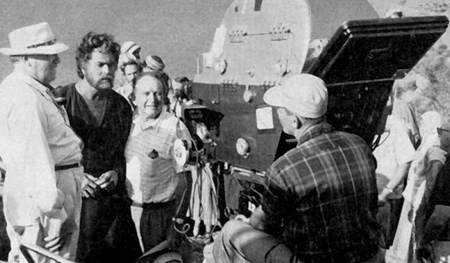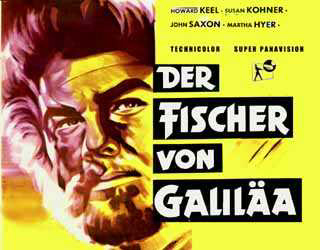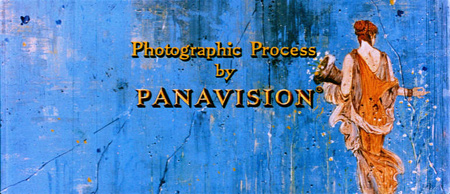"The Big Fisherman"
|
Read more
at in70mm.com The 70mm Newsletter |
| Written by: Thomas Hauerslev | Issue 51 - December 1997 |
 After publication of the 70mm
film list in issue 50, I received several e-mails about the photography of
"The Big Fisherman". I admit to have made an error. Thanks to many readers
and their wealth of knowledge the error has been corrected. I called
Panavision and got in touch with Don Earl (in charge of Panavision 65mm
department) and Takuo (Tak) Miyagishima (Sr. Vice president engineering) and
they both confirmed "Fisherman" was filmed in [Super] Panavison and that it
was the first non-anamorphic 65mm filmed with Panavision equipment (Followed
by "West Side Story" and "Exodus"). After publication of the 70mm
film list in issue 50, I received several e-mails about the photography of
"The Big Fisherman". I admit to have made an error. Thanks to many readers
and their wealth of knowledge the error has been corrected. I called
Panavision and got in touch with Don Earl (in charge of Panavision 65mm
department) and Takuo (Tak) Miyagishima (Sr. Vice president engineering) and
they both confirmed "Fisherman" was filmed in [Super] Panavison and that it
was the first non-anamorphic 65mm filmed with Panavision equipment (Followed
by "West Side Story" and "Exodus"). Additionally "South Pacific" was a Todd-AO movie, and the Panavision main title credit was due to the printer lenses for making 35mm reduction prints. |
More
in 70mm reading: “The Big Fisherman”: The North American 70mm Engagements SUPER PANAVISION 70 Large Format 7OMM Engagements Motion pictures photographed in Super Panavision 70 & Panavision System 65 |
E-mails about "The Big Fisherman" |
|
 In your list of large format films you have "The Big Fisherman" listed as
Ultra Panavision 70. There seems to be some controversy about this film. I
faxed you a copy of an ad that appeared on January 26, 1960 for the opening
of
"The Big Fisherman". As you can see, it was advertised in Panavision 70.
I know that this theatre never had Ultra Panavision 70 projection lenses. By
the way they had Bauer U2s. In your list of large format films you have "The Big Fisherman" listed as
Ultra Panavision 70. There seems to be some controversy about this film. I
faxed you a copy of an ad that appeared on January 26, 1960 for the opening
of
"The Big Fisherman". As you can see, it was advertised in Panavision 70.
I know that this theatre never had Ultra Panavision 70 projection lenses. By
the way they had Bauer U2s. Bob Throop Do you know about the controversy of the format for "The Big Fisherman"? It seems even though Panavision´s official list declares it to have been filmed in Ultra Panavision, there are some very reliable sources that assure me that it was in spherical Super Panavision 70. Scott Marshall I have always thought it was a spherical 65mm film. The inventory elements list it as 65mm, but no mention of any kind of anamorphics. Theo E. Gluck SMPTE Journal also reported that "The Big Fisherman" was photographed with spherical lenses. And yesterday, I called film format historian Rick Mitchell and asked his opinion. He believes that MGM had exclusive rights to the anamorphic 65mm process at that time. This would be yet another reason why it would be filmed with spherical lenses. Dan Sherlock In the mid 70s, BMW made a 10 minute Super Panavision 70 short called "Auto-E-Motion". This film was shown for many years in the BMW museum Munich at their own 70mm theatre. "The Big Fisherman" is noted as a Ultra Panavision 70 picture. This trade name was not introduced until 1962 with "Mutiny on the Bounty". Camera 65 could not be correct, because a few years ago Panavision agreed with me, that "Fisherman" was shot with spherical. In fact "The Big Fisherman" was photographed in Super Panavision 70. I know that most sources say Camera 65, was the photographic process, but Panavision has to know better. "South Pacific" is mentioned as a Todd-AO movie. Of course, this musical was announced in this process. But perhaps an appendix should be made that, in fact, "South Pacific" was the first movie shot in Super Panavision 70, although this process was never officially named. Hans-Joachim Heuel, Bielefeld, Germany |
|
 In thinking about your question regarding
"The Big Fisherman" I can only add
this information. If someone is looking at a 65mm camera negative and it is
a flat (2,21:1) image, that does not mean that it wasn't originally an
(2,75:1) anamorphic 1,25 squeezed original. As we all know, many Ultra
Panavision 70 and MGM Camera 65 original negatives were duped into flat 70
format (2,21:1) like "Ben Hur". Although information is typically scarce,
this happened primarily because most theatre owners did not want to buy a
very expensive Ultra Panavision projection lens for what might amount to one
or two presentations in a lifetime. So there were times when anamorphic 70
films were presented in flat 70. Ironically, Cinerama theatres did not own
anamorphic lenses for 70mm, they let "Screen-Stretch" unsqueeze the image,
although the objects in the center of the image must have looked thin. In thinking about your question regarding
"The Big Fisherman" I can only add
this information. If someone is looking at a 65mm camera negative and it is
a flat (2,21:1) image, that does not mean that it wasn't originally an
(2,75:1) anamorphic 1,25 squeezed original. As we all know, many Ultra
Panavision 70 and MGM Camera 65 original negatives were duped into flat 70
format (2,21:1) like "Ben Hur". Although information is typically scarce,
this happened primarily because most theatre owners did not want to buy a
very expensive Ultra Panavision projection lens for what might amount to one
or two presentations in a lifetime. So there were times when anamorphic 70
films were presented in flat 70. Ironically, Cinerama theatres did not own
anamorphic lenses for 70mm, they let "Screen-Stretch" unsqueeze the image,
although the objects in the center of the image must have looked thin.The only way I know how to determine whether or not any printed image was originally photographed in an anamorphic process is to view the images and look for "extra-focal images". "Extra-focal images" are those images which are very out of focus that have a singular shape. When those images are photographed with a scope lens, it will distort the "extra-focal image" in the opposite direction of its compression. In other words, an out of focus car headlight photographed with a 2:1 scope lens will look like a vertical ellipse. Now with a 1,25:1 squeeze of Ultra Panavision these "extra-focal images" will look "egg shaped" and only slightly oblong. If there is no anamorphosis involved and an image is photographed with a flat lens (i.e. Super Panavision, Todd-AO) these "extra-focal images" will look like perfect circles. PS Bob Harris and James Katz are working for Universal. They are working on a restoration of "Rear Window". It was originally 1,66:1 flat and that is how the restoration is being done, no 65mm. John O'Callaghan, Los Angeles, USA |
|
 29. december 2013 29. december 2013Hi Thomas, Just looking at different pages on your site and I came across "The Big Fisherman" page. I was talking to Tak at Panavision many years ago and he told me that Lee Garmes shot the entire film with a 40mm spherical lens. Tak said that he thought it was the best film ever shot in Super Panavision 70, interesting! Happy New Year! Best, Robert Weisgerber |
|
|
Go: back
- top - back issues
- news index Updated 22-01-25 |
|
